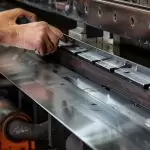Aluminum fabrication transforms aluminum into custom parts, components, or complete products serving limitless applications across diverse industries. The versatility, durability, sustainability, and cost-efficiency of fabricated aluminum parts make this material a top choice for manufacturing businesses. However, not all aluminum fabricators offer the same level of quality, reliability, and service.
Post your Requirement
Choosing the right fabrication partner is paramount for constructing custom aluminum parts that match specifications. This article will explore key factors to evaluate when selecting an aluminum fabricator, including years of experience, technical capabilities, and expertise, equipment, and technologies utilized, project involvement depth, timeliness and scheduling assurance, and competitiveness of quoting. Weighing these vital elements prudently helps companies pick aluminum fabricators promising the highest-caliber outputs and responsive project coordination. Partnerships with trustworthy, capable aluminum fabrication professionals that consistently deliver per expectations save manufacturers money and headaches while enabling them to get innovative aluminum products to market faster.
Assessing Experience and Expertise
The experience level of an aluminum fabrication company provides critical insight into expected performance. Generally, highly seasoned aluminum fabricators have honed operations over many years, solving roadblocks and optimizing productivity. They retain skilled craftspeople across essential fabrication processes like precision cutting, welding, bonding, finishing, powder coating, anodizing, and quality assurance testing.
Advanced expertise stems from a considerable time in business, but leadership vision to stay atop technical advances and industry best practices also counts. Evaluate an aluminum fabricator’s commitment to continual improvement by examining employee training programs, recruiting standards, certifications held, investments in upgrading equipment, and achievements of quality benchmarks like ISO compliance. Fabricators intimately aware of the latest techniques and technologies for fabricating aluminum apply this knowledge to lift quality and solve complex manufacturing challenges.
Discover how closely potential aluminum fabricators listen to customer needs and design intents during preliminary consultations. Besides years of handling similar applications, customized aluminum product creation hinges on a fabricator’s ability to translate specifications into reality. Fabricators proactive in shaping early-phase concepts often optimize manufacturability. They identify and rectify limiting design aspects or impractical material selections upfront rather than encountering obstacles mid-project that compromise cost and schedule. Assessing technical acumen, ingenuity in overcoming fabrication difficulties, and attentiveness to objectives during initial discussions forecast an aluminum fabricator’s readiness to deliver as envisioned.
Evaluating Equipment and Technology Utilised
Sophisticated equipment and advanced technological capabilities enable aluminum fabricators to achieve precision, consistency, efficiency, and quality mandates for customized aluminum component manufacturing. Fabricators lacking investment in modern fabrication tools and digital systems simply cannot optimize productivity or meet certain dimensional tolerances and finishes without expending substantial manual labor and time.
Fabricators serious about capturing demand for high-quality aluminum products integrate automated and computer-controlled equipment like CNC machining centers, CNC press brakes, precision cutting devices, 3D laser scanning, robotic welders, and digitized inspection devices. These hallmarks of an up-to-date fabrication facility amplify the accuracy of intricate cuts, repeatability of production steps, speed in generating test samples and finishing complex components, and reduce expenses associated with errors requiring rework.
Additionally, leading aluminum fabricators adopt manufacturing execution systems (MES) to synchronize flows between equipment, digitally collate project data from design through inspection, enhance supply chain interactions, and continuously pinpoint potential process refinements. The collective impact of progressive fabrication machinery and interconnected digital systems permits consistent on-time delivery of aluminum parts and products passing muster during quality audits.
Before engaging an aluminum fabricator, ask for a tour of production facilities and get detailed descriptions of key equipment used over essential fabrication stages. Understanding capabilities from a machinery and technology standpoint foreshadows whether a fabricator can realistically meet project expectations. Up-to-date capital equipment guided by advanced digital integration indicates aluminum fabricators pursuing continuous betterment necessary for addressing sophisticated fabrication assignments.
Evaluating Production Involvement and Timeframes
Among the criteria for choosing an aluminum fabricator, assessing how early they interface on project particulars and their assurance of on-time delivery merit weighted attention. The earliest involvement from a fabricator affords the best odds of circumventing roadblocks during planning which later disrupt budgets and schedules. Knowledgeable fabricators contribute valued guidance around manufacturability or design adjustments preventing fabrication hang-ups. They identify unrealistic tolerances for example or aluminum grades prone to warping unless properly reinforced during machining procedures. Finding and fixing these issues ahead of production runs saves clients substantial sums over scrapping lots of finished parts failing to meet targets shared across concept reviews.
Fabricators versed in forecasting practical production timelines for common aluminum fabrication processes like forming, cutting, machining, finishing, and welding have an advantage as well. They gather all specifications, run through every production step at each station in detail, incorporate typical queue durations, and apply historical data on potential hiccups to accurately predict project timeframes. Their expertise in sequencing specialized work cells to avoid bottlenecks while accommodating queued jobs enables delivery per committed project dates. Tracking record on-time percentage rates gives clients a quantifiable metric signalling whether an aluminum fabricator’s word on delivery is dependable.
Conversely, fabricators casual about nailing down deliverables lists, design reviews, work instructions for each fabrication step, material lead times, processing batch sizes, quality assurance checkpoints, and packaging/shipping arrangements should raise red flags. Progress hinging on vague verbal assurances alone invites mismatched expectations around finished part particulars, change orders inflating costs, and unreliable delivery dates.
During aluminum fabricator selections, those demonstrating attentiveness to project realities from the beginning and willingness to iron out fabrication concerns early inspire the most confidence. This shows discipline around planned production that transfers reliably from sales commitments to quality outputs shipped per schedule promises.
Pricing Considerations
With many construction and manufacturing applications dependent on aluminum for its combined strength, durability, and lightweight, cost factors cannot be dismissed during aluminum fabrication selections. Fortunately, common aluminum alloys offer cost savings over materials like stainless steel. However, material grades within aluminum still impact end pricing as do part sizes, order volumes, specialty finishes or treatments, expedited lead requests, secondary processing steps, quality testing needs, shipping modes, and project intricacies.
Savvy buyers realize quoting is an imprecise process for custom aluminum fabrication lacking detailed specifications. Ballpark figures at least provide comparisons assuming identical sizes, aluminum types, processing methods, quality levels, and delivery areas. Where quotes vary wildly on supposedly equivalent projects, either a gross pricing disconnect exists or bids fail to normalize enough project variables across respondents to enable apples-to-apples value comparisons.
Request fabricators itemize all cost components in proposals like materials, equipment setups, production labor including any outsourced steps, in-house design work, expedited fees if imposed, applicable secondary processing, QA testing services, crating methodology, freight, and sales tax among key elements. This billing transparency spotlights where one proposal nets savings, helps confirm quotes address the identical opportunity scope, and aids negotiations around optimizing expenditures if over budget.
Ultimately cost dictates some buyer decisions regardless of a fabricator’s capabilities, experience, and expertise. But balancing price with expected performance weighted across the factors above when selecting aluminum fabricators curtails chances of sacrificing quality, reliability, or outcomes later. Sourcing proposals from trustworthy fabricators followed by open Capex discussions locates cost/value sweet spots.
Conclusion
Reliably procuring aluminum parts fabricated properly to exacting specifications requires partnering with competent, communicative, and consistent aluminum manufacturing specialists. The factors above underscore key considerations manufacturers and construction companies must evaluate when choosing aluminum fabricators to deliver critical components influencing end products.
Years of direct fabrication experience, retention of adept personnel, investments in the latest production technologies, sharp attention to operational efficiencies, expertise preventing design limitations proactively, and cost transparency set certain aluminum fabricators apart. Firms focused on these vital facets earn reputations for responsiveness, measurable quality, and hitting delivery targets that justify selection even at slightly elevated pricing. With so many essential construction, equipment, and consumer products now leveraging fabricated aluminum for its sustainability, strength, and energy efficiency attributes, selecting the optimal aluminum manufacturing partner makes or breaks eventual market success. Keeping these criteria at the forefront of decision processes directs buyers to aluminum fabricators producing outcomes reaching performance and financial expectations.























Post A Comment